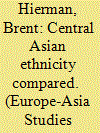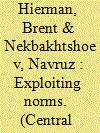| Srl | Item |
| 1 |
ID:
139268


|
|
|
|
|
| Summary/Abstract |
In this article, I utilise a contextual understanding of ethnicity and unique data to demonstrate that the ethnic Uzbek identity category is both widely available and frequently a useful means of making sense of the world in both Kyrgyzstan and Tajikistan. While Uzbek ethnicity is generally salient in both states, the context in which it becomes so varies across space. In particular, there are significant urban–rural distinctions that affect when Uzbek ethnicity is utilised to interpret the world. In addition, compared to others, rural Tajikistani Uzbeks perceive that the boundary between Uzbeks and the titular groups is particularly permeable.
|
|
|
|
|
|
|
|
|
|
|
|
|
|
|
|
| 2 |
ID:
178468


|
|
|
|
|
| Summary/Abstract |
This article advances a straightforward argument: a complete analysis of land reform processes in Central Asia needs to account for gender dynamics. More explicitly, it argues that alongside the feminization of agriculture, customary gender norms restricting female economic opportunities and property acquisition represent a structural advantage for local elites interested in hindering or delaying the process of farm individualization in Tajikistan. After overviewing the gap between female legal rights to agricultural land and the actualization of these rights in four Central Asian states (Kazakhstan, Kyrgyzstan Tajikistan and Uzbekistan) the article narrows its focus to Tajikistan. After regression analyses reveal that gendered information gaps are insufficient to account for gaps in the registration of farmland, the study presents qualitative data examining the relationship between female-headed households and the slow pace of agrarian change in Tajikistan.
|
|
|
|
|
|
|
|
|
|
|
|
|
|
|
|
| 3 |
ID:
187520


|
|
|
|
|
| Summary/Abstract |
Regimes generally possess multifaceted repressive repertoires. When faced with societal challengers, a regime can utilize overt or covert forms of coercion as well as indirect forms of repression, known as channeling. Using case material from Central Asia, this article investigates the interplay between channeling and coercion in two contexts: 1) the regulation of civil liberties; and 2) Kazakhstan’s efforts to demobilize a protest wave. Through an overview of freedom of assembly laws across the region, we demonstrate that most Central Asian states mix coercive and channeling tactics to limit opportunities for contentious acts. We then analyze Kazakhstan’s repressive reactions to a single coherent national protest wave (the 2016 anti-land reform protest). Our analysis reveals that in response to the threat of these protests, the Kazakhstani regime utilized coercive and channeling tactics in roughly equal measure. We show that the most prominent form of channeling attempted was elite mediation, whereby officials personally encouraged protesters to relocate to non-public spaces and/or offered to articulate collective grievances to higher authorities in exchange for protest dispersal. Through evaluating the role of channeling in this wave we demonstrate how non-democratic regimes can maintain regime stability when challenged without relying solely on overt forms of coercion.
|
|
|
|
|
|
|
|
|
|
|
|
|
|
|
|